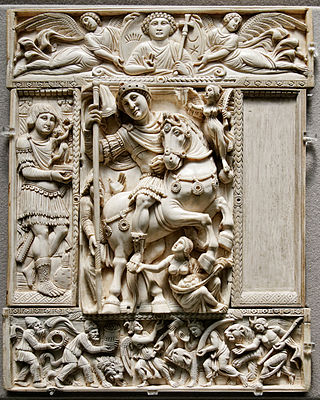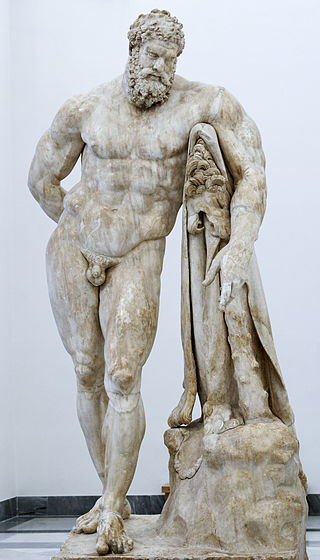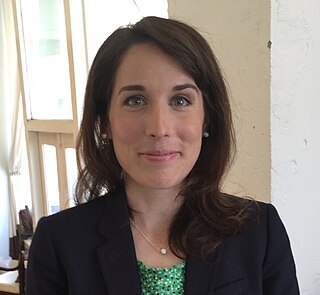
The University of Manitoba is a public research university in Winnipeg, Manitoba, Canada. Founded in 1877, it is the first university of Western Canada. Both by total student enrolment and campus area, the University of Manitoba is the largest university in the province of Manitoba. Its main campus is located in the Fort Garry neighbourhood of Winnipeg, with other campuses throughout the city: the Bannatyne Campus, the James W. Burns Executive Education Centre, the William Norrie Centre, and the French-language affiliate, Université de Saint-Boniface in the Saint Boniface ward.

Late antiquity is sometimes defined as spanning from the end of classical antiquity to the local start of the Middle Ages, from around the late 3rd century up to the 7th or 8th century in Europe and adjacent areas bordering the Mediterranean Basin depending on location. The popularisation of this periodization in English has generally been credited to historian Peter Brown, who proposed a period between 150–750 AD. The Oxford Centre for Late Antiquity defines it as "the period between approximately 250 and 750 AD". Precise boundaries for the period are a continuing matter of debate. In the West, its end was earlier, with the start of the Early Middle Ages typically placed in the 6th century, or even earlier on the edges of the Western Roman Empire.

Pontic Olbia or simply Olbia is an archaeological site of an ancient Greek city on the shore of the Southern Bug estuary in Ukraine, near the village of Parutyne. The archaeological site is protected as the National Historic and Archaeological Preserve. The preserve is a research and science institute of the National Academy of Sciences of Ukraine. In 1938–1993 it was part of the NASU Institute of Archaeology as a department.

In Greek mythology and religion, the thiasus was the ecstatic retinue of Dionysus, often pictured as inebriated revelers. Many of the myths of Dionysus are connected with his arrival in the form of a procession. The grandest such version was his triumphant return from "India", which influenced symbolic conceptions of the Roman triumph and was narrated in rapturous detail in Nonnus's Dionysiaca. In this procession, Dionysus rides a chariot, often drawn by big cats such as tigers, leopards, or lions, or alternatively elephants or centaurs.

The study of Roman sculpture is complicated by its relation to Greek sculpture. Many examples of even the most famous Greek sculptures, such as the Apollo Belvedere and Barberini Faun, are known only from Roman Imperial or Hellenistic "copies". At one time, this imitation was taken by art historians as indicating a narrowness of the Roman artistic imagination, but, in the late 20th century, Roman art began to be reevaluated on its own terms: some impressions of the nature of Greek sculpture may in fact be based on Roman artistry.
Cornelius Clarkson Vermeule III was an American scholar of ancient art and curator of classical art at the Museum of Fine Arts, Boston, from 1957 to 1996. He was also well known as a numismatist. He also used the pseudonyms Wentworth Bunsen, Isao Tsukinabe and Northwold Nuffler.

The bronze Seated Hermes, found at the Villa of the Papyri in Herculaneum in 1758, is at the National Archaeological Museum of Naples. "This statue was probably the most celebrated work of art discovered at Herculaneum and Pompeii in the eighteenth century", Francis Haskell and Nicholas Penny have observed, once four large engravings reproducing it had appeared in Le Antichità di Ercolano, 1771. To protect it from Napoleonic depredations, it was packed into one of the fifty-two cases of antiquities and works of art that accompanied the Bourbon flight to Palermo in 1798. It was once again in the royal villa at Portici in 1816.

David John Mattingly, FBA is an archaeologist and historian of the Roman world. He is currently Professor of Roman Archaeology at the University of Leicester.

The Lamta Archaeological Museum is an archaeological museum located in Lamta, Tunisia.
Hazel Dodge is senior Lecturer of Roman Archaeology at Trinity College, Dublin. She holds her degrees from the University of Newcastle-Upon-Tyne and her research interests include the Eastern Roman Empire, the Roman construction industry and the city of Rome. Her PhD concerns the use and distribution of marble from the Eastern Empire. She has published extensively on Roman archaeology often in collaboration with colleagues such as Peter Connolly and Jon Coulston to whom she is married. One of her most notable publications is "the Archaeology of the City of Rome" and most recently she has published a volume on spectacle in the Roman World for Bristol Classical Press. A new source book on Rome with Jon Coulston and Christopher Smith is forthcoming. In 2010/11 she was a guest lecturer with the Archaeological Institute of America.

The classical sculptures in the Farnese Collection, one aspect of this large art collection, are one of the first collections of artistic items from Greco-Roman antiquity. It includes some of the most influential classical works, including the sculptures that were part of the Farnese Marbles, their collection of statuary, which includes world-famous works like the Farnese Hercules, Farnese Cup, Farnese Bull and the Farnese Atlas. These statues are now displayed in the Naples National Archaeological Museum in Italy with some in the British Museum in London.

The Kelsey Museum of Archaeology is a museum of archaeology located on the University of Michigan central campus in Ann Arbor, Michigan, in the United States. The museum is a unit of the University of Michigan's College of Literature, Science, and the Arts. It has a collection of more than 100,000 ancient and medieval artifacts from the civilizations of the Mediterranean and the Near East. In addition to displaying its permanent and special exhibitions, the museum sponsors research and fieldwork and conducts educational programs for the public and for schoolchildren. The museum also houses the University of Michigan Interdepartmental Program in Classical Art and Archaeology.

Anna Marguerite McCann was an American art historian and archaeologist. She is known for being an early influencer—and the first American woman—in the field of underwater archaeology, beginning in the 1960s. McCann authored works pertaining to Roman art and Classical archaeology, and taught both art history and archaeology at various universities in the United States. McCann was an active member of the Archaeological Institute of America, and received its Gold Medal Award in 1998. She also published under the name Anna McCann Taggart.

Julia Hillner is Professor for Dependency and Slavery Studies at the University of Bonn. She was previously Professor of Medieval History at the University of Sheffield. She is an expert on late antiquity, applying digital methods of social network analysis to large data sets drawn from a wide variety of late antique and early medieval sources.
Rubina Raja is a classical archaeologist educated at University of Copenhagen (Denmark), La Sapienza University (Rome) and University of Oxford (England). She is professor (chair) of classical archaeology at Aarhus University and centre director of the Danish National Research Foundation's Centre of Excellence for Urban Network Evolutions (UrbNet). She specialises in the cultural, social and religious archaeology and history of past societies. Research foci include urban development and network studies, architecture and urban planning, the materiality of religion as well as iconography from the Hellenistic to Early Medieval periods. Her publications include articles, edited volumes and monographs on historiography, ancient portraiture and urban archaeology as well as themes in the intersecting fields between humanities and natural sciences. Rubina Raja received her DPhil degree from the University of Oxford in 2005 with a thesis on urban development and regional identities in the eastern Roman provinces under the supervision of Professors R.R.R. Smith and Margareta Steinby. Thereafter, she held a post-doctoral position at Hamburg University, Germany, before she in 2007 moved to a second post-doctoral position at Aarhus University, Denmark. In 2011–2016, she was a member of the Young Academy of Denmark, where she was elected chairwoman in 2013.

Ida Östenberg is a Roman historian, working in the areas of Roman political culture, Roman rituals, performances and spectacles, and Classical reception. She is known in particular for her work on the Roman triumph, and is an expert selected by the Swedish Research Council for inclusion in AcademiaNet. She is the 2018 winner of the Stora historiepriset, Sweden's largest history prize.

Sarah Emily Bond is an Associate Professor of History at the University of Iowa. Her research focuses on late Roman history, epigraphy, law, topography, GIS, and digital humanities.

Jennifer Baird, is a British archaeologist and academic. She is Professor in Archaeology at Birkbeck, University of London. Her research focuses on the archaeology of Rome's eastern provinces, particularly the site of Dura-Europos.
Ann Marie Yasin is an Associate Professor of Art History and Classics at the University of Southern California specializing in the architecture and material culture of the Roman and late antique world. She studies materiality, built-environments, landscapes, and urbanism as they pertain to the ancient and late ancient religious worlds.

Maijastina Kahlos is a Docent of Latin and Roman literature at the University of Helsinki and a Life Member of Clare Hall, University of Cambridge. She specialises in migration and mobility in the late antique Mediterranean, everyday life in ancient Rome, and ancient religions.















